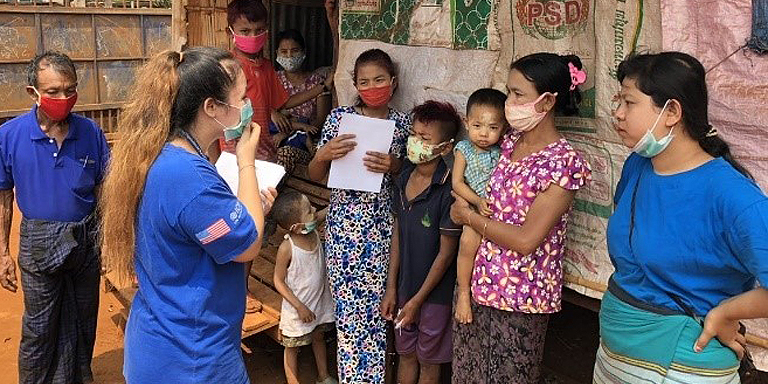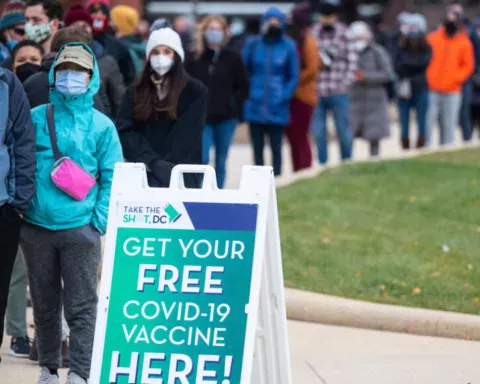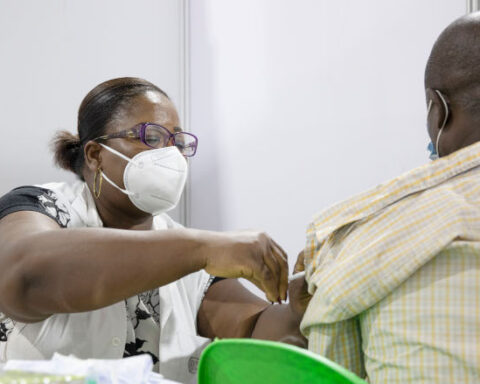People on the move are among the highly vulnerable groups to the coronavirus disease (COVID-19) crisis. The disproportionate impact on this group, which includes immigrants and those still crossing borders, shows in the unprecedented, multiple challenges they face in health, livelihood, and additionally for those fleeing war and persecution, in access to protection. These heighten their risk of infection, which has implications on the health of their families and communities.
It is urgent for governments to integrate migrant health and migration policies into their response and recovery efforts. Migrants must have access to COVID-19 health services and be enabled to cope with the socioeconomic impacts of the pandemic. Otherwise, their increasing vulnerability could impede efforts to stop the spread of the disease. It is also important to coordinate with governments of host and destination countries on measures targeted at migrants.
Focusing on migrant health and international migration, this brief proposes some policy measures to operationalize an inclusive approach based on the principles of universal health coverage (UHC) and contribute to enhancing public health protection, speeding recovery, and achieving sustainable development. It is based on presentations made at the Policy Actions for COVID-19 Response Dialogues organized by the Asian Development Bank (ADB).
Impacts of COVID-19
As of mid-2019, international migrants totaled 272 million, including 164 million workers and 25.9 million refugees (United Nations 2020) but excluding the numerous migrants that are undocumented. While the extent to which COVID-19 impacts migrants varies, depending on their socioeconomic situation, most count among the most severely hit by the crisis and are at greater risk of infection because of preexisting inequities and vulnerabilities. They are particularly vulnerable to COVID-19 because of the circumstances of their journey and their poor living and working conditions. Impacts bear more heavily on women and children, the elderly, and persons with impairments and/or medical conditions.
Increased health risks. Lockdowns and quarantines have intensified the health risks of refugees and migrant workers living in overcrowded camps, informal settlements, collective shelters, and dormitories, often lacking in water, sanitation, and other basic services. Impacts are greater among irregular migrants, who are forced to move from place to place, stay homeless for prolonged periods, or be confined in cramped detention centers. Rising joblessness, income losses, malnutrition, and food insecurity triggered by the pandemic have also amplified these risks.
Compromised access to health services. Obstacles to migrants’ access to healthcare have heightened with the surge in COVID-19 caseloads and local transmissions. A glaring manifestation is the rising acts of xenophobia and stigma and discrimination. Along with other obstacles, such as migration status, lack of information, absence of health insurance or inadequate finances, and language and cultural barriers, these incidents have deepened their marginalization. Irregular migrants, who are unable or unwilling to access services for fear of detention, deportation, and other punishments, have been particularly impacted. Migrant workers in the informal economy, who often are without contracts and insurances and excluded from social protection schemes, have also been significantly affected.
Rising unemployment and loss of livelihood. The COVID-19-induced economic crisis has cost migrants their jobs and livelihoods. First to go were workers and refugees in the low-wage informal economy. Recent research from the International Labor Organization shows that nearly 75% of migrant women and 70% of migrant men were working in the informal sector before COVID-19. The prevalent “last hired, first fired” practice also makes migrant workers in the formal sector more vulnerable to losing their jobs than their native-born counterparts. The unfolding global economic recession, according to ADB, threatens the job security of over 91 million international migrants from Asia and the Pacific.
Declining remittances. Migrants’ income losses impact their families and countries of origin. The World Bank estimates that remittances will drop by 20% because of the pandemic, causing hardship to more than 800 million people depending on remittances for much of their subsistence. A sudden stop in remittance flow, according to ADB, could plunge many households in developing Asia—particularly Pacific and Central and West Asian countries—into poverty. The region has at least 10 countries deriving over 10% of their gross domestic product from remittances and six of the world’s top 10 remittance-recipient countries (ADB 2020).
Implications on migration
The pandemic has brought new challenges to migration management. Current developments indicate that as countries reopen their borders, they will be imposing additional health requirements for travel, which could result in disproportionate health expenditures and drive more people into irregular migration pathways. They could also restrict travel and tourism and limit the potential of migration and human mobility in contributing to development.
Challenges could become much more complex with broader geopolitical and economic contexts coming into play in addition to changes in the evolutionary patterns of the disease. Against this backdrop, rethinking mobility and migration management, as part of COVID-19 response and recovery measures, assumes critical importance.
Policy Options
A three-track policy agenda may be explored to address the complex challenges posed by COVID-19 to migrant health and immigration. Key considerations that need to inform country policies on each track are outlined below.
A strong case can be made for a migrant-inclusive approach to disease control. Research and empirical evidence show migrants rarely bring infections to their host populations, but denying them care could create risks and lead to higher costs in the long run (BMJ 2019).
Include migrants in COVID-19 health services. Ensure that all migrants—regardless of their status—will have access to the full range of health services to reduce the risk of transmission. Proactive and innovative measures are needed to break through the current policy and regulatory obstacles that prevent particularly the undocumented or irregular migrants from accessing these services.
Remove obstacles to access to healthcare. Address stigma and discrimination, language and cultural barriers, and lack of financial resources and information to encourage migrants to seek healthcare once they feel the symptoms. Provide a range of services to improve their knowledge about the disease, ensure their access to accurate and up-to-date information, build their confidence and communication skills, and strengthen their social support systems. Use social and behavior change communication to combat xenophobia, racism, and gender and other forms of discrimination. Provide gendered and age- and culturally appropriate mental health and psychosocial services and financial assistance, especially to irregular, stranded, laid-off, and other distressed migrants.
Reduce transmission risks throughout the mobility continuum. Detection of COVID-19 threats has largely improved at border facilities, but more needs to be done with respect to the spaces of vulnerability where migrants interact with stationary, local communities in their countries of origin, transit, and destination. Engage with community networks, migrant support groups, and migrants themselves to improve prevention education, monitor outbreaks, and facilitate emergency care and treatment in these spaces. Harmonize and coordinate COVID-19 response across sectors at various levels of governance and with governments of host and destination/return countries.
Policy implementation
The proposed policy measures require bold political decisions, leadership from the top, strong multisectoral coordination, and the involvement of migrants as key stakeholders. These requirements may be met through the following institutional arrangements and processes.
Strong political leadership and multisectoral coordination
An executive/steering committee, comprising senior government officials from immigration, foreign affairs, labor, health, and social welfare departments, among others, and representatives from migrant organizations or their support groups, may be formed as the central decision-making body. A core unit, composed of senior staff from relevant agencies and departments and migrant leaders and advocates, may be established to supervise and coordinate implementation.
Involvement of migrants as key stakeholders
Migrants can participate in decision-making as members of the steering committee and in policy implementation. Migrant participation will be inclusive of all their key networks/organizations.
Partnership and collaboration
The core implementation unit should ensure that other relevant stakeholders will be involved through partnership arrangements, which may be formed based on the spaces of vulnerability and communities where actual work needs to take place. Diaspora organizations and immigrant health professionals will be tapped to support community education and prevention activities as well as provide essential referral services, as needed.
Regional cooperation and development partner support
Build upon existing bilateral and multilateral cooperation among countries to implement the policies and respond to migrant issues and concerns during the COVID-19 crisis and beyond. Multi-country knowledge sharing can support national-level policy implementation and regional cooperation and enhance both as the situation unfolds. Mobilizing and innovating to meet financing needs will be encouraged as a shared responsibility among key stakeholders.
Good Practice Examples
These initiatives provide examples of a migrant-inclusive approach to COVID-19 response and recovery.
Including all migrants in COVID-19 health services
- Portugal has temporarily regularized irregular migrants to ensure their full access to COVID-19 services.
- Peru has approved temporary health coverage for migrants and refugees suspected of or testing positive for COVID-19.
- The United Kingdom has announced that no charges will apply for the diagnosis or treatment of COVID‐19 for all foreign visitors, regardless of their residency/immigration status.
- In Lebanon, humanitarian agencies and health partners undertook outreach campaigns to provide information to refugee populations on COVID-19.
- Singapore has set up medical facilities and triage clinics in migrant workers’ dormitories and provided them with food and other necessities, including Wi-Fi.
- City mayors from all over the world, through the Leadership Board of the Mayors Migration Council, are calling on national and international decision-makers to commit to an equitable pandemic response and recovery.





